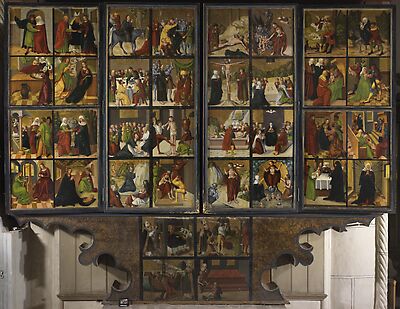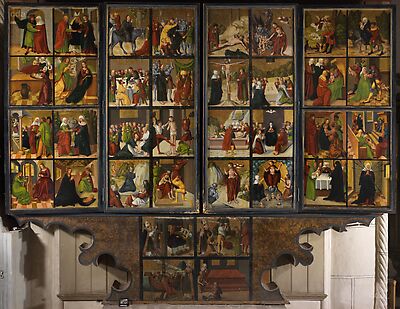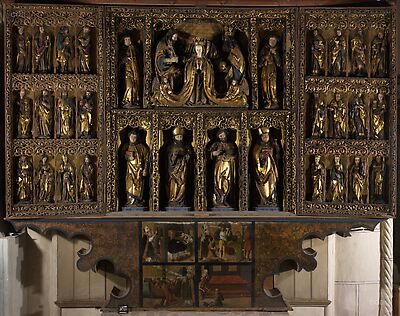Christ Nailed to the Cross (no infrared reflectogram available)
Christ on the Cross
DESCRIPTION
Tools/Material:
- the initial design in a dry drawing material, stylus (visible along Christ’s arm), followed by a fluid, black medium, brush (?)
Type/Ductus:
- freehand underdrawing after a pre-existing design
- delicate to thin lines
Function:
- binding for the final painted version; the lines define the main contours and describe essential details and facial features; no representation of volume with hatching strokes
Deviations:
- minor corrections were made to forms during the painting process, small changes
INTERPRETATION
Attribution:
- not possible (not Cranach workshop)
The Deposition
DESCRIPTION
Tools/Material:
- dry drawing material, stylus (?)
Type/Ductus:
- freehand underdrawing
- delicate lines
- construction lines
Function:
- binding for the final painted version; the lines define the main contours and describe essential details and facial features; no representation of volume with hatching strokes
Deviations:
- almost no corrections were made to forms during the painting process; small changes
INTERPRETATION
Attribution:
- not possible (not Cranach workshop)
The Resurrection
DESCRIPTION
Tools/Material:
- dry drawing material, stylus; possibly reinforces with a fluid, black medium, brush (?)
Type/Ductus:
- freehand underdrawing after a pre-existing
- delicate to thin lines
Function:
- binding for the final painted version; the lines define the main contours and describe essential details and facial features; no representation of volume with hatching strokes
Deviations:
- almost no corrections were made to forms during the painting process; almost no changes
INTERPRETATION
Attribution:
- not possible (not Cranach workshop)
Christ’s descent into Hell (an infrared reflectogram is not available)
The Ascension
DESCRIPTION
Tools/Material:
- the initial design was executed with a dry drawing material, stylus; possibly reinforced with a fluid medium, brush
Type/Ductus:
- freehand underdrawing after a pre-existing design
- delicate to thin lines
- construction lines
Function:
- binding to relatively binding for the final painted version; the lines define the main contours and describe essential details and facial features; no representation of volume with hatching strokes
Deviations:
- minor corrections were made to forms during the painting process; small changes (e. g. Christ’s footprints)
INTERPRETATION
Attribution:
- not possible (not Cranach workshop)
Penticost
DESCRIPTION
Tools/Material:
- stylus (?)
Type/Ductus:
- freehand underdrawing after a pre-existing design
- thin, delicate lines
Function:
- binding for the final painted version; the lines define the main contours and describe essential details and facial features; no representation of volume with hatching strokes
Deviations:
- almost no corrections were made to forms during the painting process; small changes
INTERPRETATION
Attribution:
- not possible (not Cranach workshop)
The Last Judgement
DESCRIPTION
Tools/Material:
- the initial design was executed with a dry drawing material, stylus; possibly reinforced with a fluid medium, brush
Type/Ductus:
- freehand underdrawing after a pre-existing design
- delicate lines
- incised lines mark the gilded area
Function:
- binding for the final painted version; the lines define the main contours and describe essential details and facial features; no representation of volume with hatching strokes
Deviations:
- almost no corrections were made during the painting process; small changes
INTERPRETATION
Attribution:
- not possible (not Cranach workshop)
[Sandner, Heydenreich, Smith-Contini, cda 2017]
![The Bernau Altarpiece [right inner wing]: Passion of Christ [verso]](https://lucascranach.org/imageserver-2022/DE_StMB_NONE-001b_FR-none/01_Overall/DE_StMB_NONE-001b_FR-none_2016-02_Overall-s.jpg)

![The Bernau Altarpiece [left inner wing]: Passion of Christ [verso]](https://lucascranach.org/imageserver-2022/DE_StMB_NONE-001a_FR-none/01_Overall/DE_StMB_NONE-001a_FR-none_2016-02_Overall-s.jpg)
![The Bernau Altarpiece [left alteration wing]: Live of the Virgin [recto], Live of Saints [verso]](https://lucascranach.org/imageserver-2022/DE_StMB_NONE-001c_FR-none/01_Overall/DE_StMB_NONE-001c_FR-none_2016-02_Overall-s.jpg)
![The Bernau Altarpiece [right alteration wing]: The childhood of Christ [recto], Live of Saints [verso]](https://lucascranach.org/imageserver-2022/DE_StMB_NONE-001d_FR-none/01_Overall/DE_StMB_NONE-001d_FR-none_2016-02_Overall-s.jpg)
![The Bernau Altarpiece [left side wing]: The Golden Legend (Aurea Legenda)](https://lucascranach.org/imageserver-2022/DE_StMB_NONE-001e_FR-none/01_Overall/DE_StMB_NONE-001e_FR-none_2016-02_Overall-s.jpg)
![The Bernau Altarpiece [right side wing]: The Golden Legend (Aurea Legenda)](https://lucascranach.org/imageserver-2022/DE_StMB_NONE-001f_FR-none/01_Overall/DE_StMB_NONE-001f_FR-none_2016-02_Overall-s.jpg)
![The Bernau Altarpiece [predella]: St Nicholas legend](https://lucascranach.org/imageserver-2022/DE_StMB_NONE-001g_FR-none/01_Overall/DE_StMB_NONE-001g_FR-none_2016-02_Overall-s.jpg)


